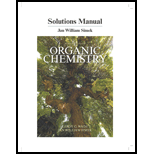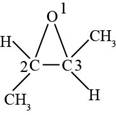
Concept explainers
Write structural formulas for the following compounds.
- a. ethyl isopropyl ether
- b. di-n-butyl ether
- c. 2-ethoxyoctane
- d. divinyl ether
- e. allyl methyl ether
- f. cyclohexene oxide
- g. cis-2,3-epoxyhexane
- h. (2R, 3S)-2-methoxypentan-3-ol
- i. trans-2,3-dimethyloxirane
(a)
Interpretation:
The structure formula for the given compound is to be drawn.
Concept introduction:
An organic compound where an oxygen atom is attached to two alkyl or aryl groups is known as ether. The general formula of ethers is
Answer to Problem 14.29SP
The structure of ethyl isopropyl ether is shown in Figure 1.
Explanation of Solution
The given compound is ethyl isopropyl ether. The root name isopropyl signifies three carbon atoms in a chain. Ethyl and isopropyl are the groups attached to an oxygen atom. The structure of ethyl isopropyl ether is shown below.

Figure 1
(b)
Interpretation:
The structure formula for the given compound is to be drawn.
Concept introduction:
An organic compound where an oxygen atom is attached to two alkyl or aryl groups is known as ether. The general formula of ethers is
Answer to Problem 14.29SP
The structure of di-n-butyl ether is shown in Figure 2.
Explanation of Solution
The given compound is di-n-butyl ether. The root name butyl signifies four carbon atoms in a chain and di-n-butyl indicates that two butyl groups are attached to an oxygen atom. The structure of di-n-butyl ether is shown below.

Figure 2
(c)
Interpretation:
The structure formula for the given compound is to be drawn.
Concept introduction:
An organic compound where an oxygen atom is attached to two alkyl or aryl groups is known as ether. The general formula of ethers is
Answer to Problem 14.29SP
The structure of 2-ethoxyoctane is shown in Figure 3.
Explanation of Solution
The given compound is 2-ethoxyoctane. The root octane signifies eight carbon atoms in a chain and 2-ethoxy shows that ethoxy group is present at second carbon atom of a chain. The structure of 2-ethoxyoctane is shown below.

Figure 3
(d)
Interpretation:
The structure formula for the given compound is to be drawn.
Concept introduction:
An organic compound where an oxygen atom is attached to two alkyl or aryl groups is known as ether. The general formula of ethers is
Answer to Problem 14.29SP
The structure of divinyl ether is shown in Figure 4.
Explanation of Solution
The given compound is divinyl ether. The Vinyl group is the functional group having a formula

Figure 4
(e)
Interpretation:
The structure formula for the given compound is to be drawn.
Concept introduction:
An organic compound where an oxygen atom is attached to two alkyl or aryl groups is known as ether. The general formula of ethers is
Answer to Problem 14.29SP
The structure of allyl methyl ether is shown in Figure 5.
Explanation of Solution
The given compound is allyl methyl ether. An allyl group is used as a substituent and has a formula of

Figure 5
(f)
Interpretation:
The structure formula for the given compound is to be drawn.
Concept introduction:
An organic compound where an oxygen atom is attached to two alkyl or aryl groups is known as ether. The general formula of ethers is
Answer to Problem 14.29SP
The structure of cyclohexene oxide is shown in Figure 6.
Explanation of Solution
The given compound is cyclohexene oxide. The root name cyclohexene signifies six carbon atoms in a ring and oxide indicated the presence of epoxide ring. The structure of cyclohexene oxide is shown below.

Figure 6
(g)
Interpretation:
The structure formula for the given compound is to be drawn.
Concept introduction:
An organic compound where an oxygen atom is attached to two alkyl or aryl groups is known as ether. The general formula of ethers is
Answer to Problem 14.29SP
The structure of
Explanation of Solution
The given compound is

Figure 7
(h)
Interpretation:
The structure formula for the given compound is to be drawn.
Concept introduction:
An organic compound where an oxygen atom is attached to two alkyl or aryl groups is known as ether. The general formula of ethers is
Answer to Problem 14.29SP
The structure of
Explanation of Solution
The given compound is
According to Fisher projection,
For
The structure of

Figure 8
(i)
Interpretation:
The structure formula for the given compound is to be drawn.
Concept introduction:
An organic compound where an oxygen atom is attached to two alkyl or aryl groups is known as ether. The general formula of ethers is
Answer to Problem 14.29SP
The structure of
Explanation of Solution
The given compound is

Figure 9
Want to see more full solutions like this?
Chapter 14 Solutions
Student's Solutions Manual for Organic Chemistry
- The decimolar calomel electrode has a potential of 0.3335 V at 25°C compared to the standard hydrogen electrode. If the standard reduction potential of Hg22+ is 0.7973 V and the solubility product of Hg2Cl2 is 1.2x 10-18, find the activity of the chlorine ion at this electrode.Data: R = 8.314 J K-1 mol-1, F = 96485 C mol-1, T = 298.15 K.arrow_forward2. Add the following group of numbers using the correct number of significant figures for the answer. Show work to earn full credit such as rounding off the answer to the correct number of significant figures. Replace the question marks with the calculated answers or write the calculated answers near the question marks. 10916.345 37.40832 5.4043 3.94 + 0.0426 ? (7 significant figures)arrow_forwardThe emf at 25°C of the cell: Pt l H2(g) l dis X:KCl (sat) l Hg2Cl2(s) l Hg l Pt was 612 mV. When solution X was replaced by normal phosphate buffer solution with a pH of 6.86, the emf was 741 mV. Calculate the pH of solution X.arrow_forward
- Indicate how to calculate the potential E of the reaction Hg2Cl2(s) + 2e ⇄ 2Hg + 2Cl- as a function of the concentration of Cl- ions. Data: the solubility product of Hg2Cl2.arrow_forwardHow can Beer’s Law be used to determine the concentration in a selected food sample. Provide an in-depth discussion and examples of this.arrow_forwardb) H3C- H3C Me CH 3 I HN Me H+arrow_forward
- Using Luther's rule, determine the reference potentials of the electrodes corresponding to the low stability systems Co³+/Co and Cr²+/Cr from the data in the table. Electrodo ΕΝ Co²+/Co Co3+/Co²+ -0,28 +1,808 Cr³+ / Cr -0,508 Cr3+ / Cr²+ -0,41arrow_forwardThe molecule PYRIDINE, 6tt electrons and is there pore aromuntre and is Assigned the Following structure contenus Since aromatk moleculey undergo electrophilic allomatic substitution, Pyridine should undergo The Following reaction + HNO3 12504 a. write all of the possible Mononitration Products that could Result From this roaction Based upon the reaction the reaction mechanism determine which of these producty would be the major Product of the hegetionarrow_forwardUsing Benzene as starting materia Show how each of the Following molecules could Ve synthesked 9. CHI d. 10450 b 0 -50311 ८ City -5034 1-0-650 e NO2arrow_forward
- BA HBr of the fol 1)=MgCI 2) H₂O major NaOEt Ts Cl Py (pyridine) 1) 03 2) Me2S 1arrow_forward4. Provide a clear arrow-pushing mechanism for the following reactions. Do not skip proton transfers, do not combine steps, and make sure your arrows are clear enough to be interpreted without ambiguity. a) NHBoc ⚫OBn HO. H3C CO2CH3 -OBn H3C H3C. H3C. NHBOC CI CO2CH3arrow_forwardDraw structures of the following compounds and identify their role: mCPBA (MCPBA) DMS Py 9-BBN LAH Sia₂BH TsCI PCC t-BuOK LDA MeLi n-BuLi DMSO DMF Sodium Borohydride Lithium DiisopropylAmide 2arrow_forward
 ChemistryChemistryISBN:9781305957404Author:Steven S. Zumdahl, Susan A. Zumdahl, Donald J. DeCostePublisher:Cengage Learning
ChemistryChemistryISBN:9781305957404Author:Steven S. Zumdahl, Susan A. Zumdahl, Donald J. DeCostePublisher:Cengage Learning ChemistryChemistryISBN:9781259911156Author:Raymond Chang Dr., Jason Overby ProfessorPublisher:McGraw-Hill Education
ChemistryChemistryISBN:9781259911156Author:Raymond Chang Dr., Jason Overby ProfessorPublisher:McGraw-Hill Education Principles of Instrumental AnalysisChemistryISBN:9781305577213Author:Douglas A. Skoog, F. James Holler, Stanley R. CrouchPublisher:Cengage Learning
Principles of Instrumental AnalysisChemistryISBN:9781305577213Author:Douglas A. Skoog, F. James Holler, Stanley R. CrouchPublisher:Cengage Learning Organic ChemistryChemistryISBN:9780078021558Author:Janice Gorzynski Smith Dr.Publisher:McGraw-Hill Education
Organic ChemistryChemistryISBN:9780078021558Author:Janice Gorzynski Smith Dr.Publisher:McGraw-Hill Education Chemistry: Principles and ReactionsChemistryISBN:9781305079373Author:William L. Masterton, Cecile N. HurleyPublisher:Cengage Learning
Chemistry: Principles and ReactionsChemistryISBN:9781305079373Author:William L. Masterton, Cecile N. HurleyPublisher:Cengage Learning Elementary Principles of Chemical Processes, Bind...ChemistryISBN:9781118431221Author:Richard M. Felder, Ronald W. Rousseau, Lisa G. BullardPublisher:WILEY
Elementary Principles of Chemical Processes, Bind...ChemistryISBN:9781118431221Author:Richard M. Felder, Ronald W. Rousseau, Lisa G. BullardPublisher:WILEY





